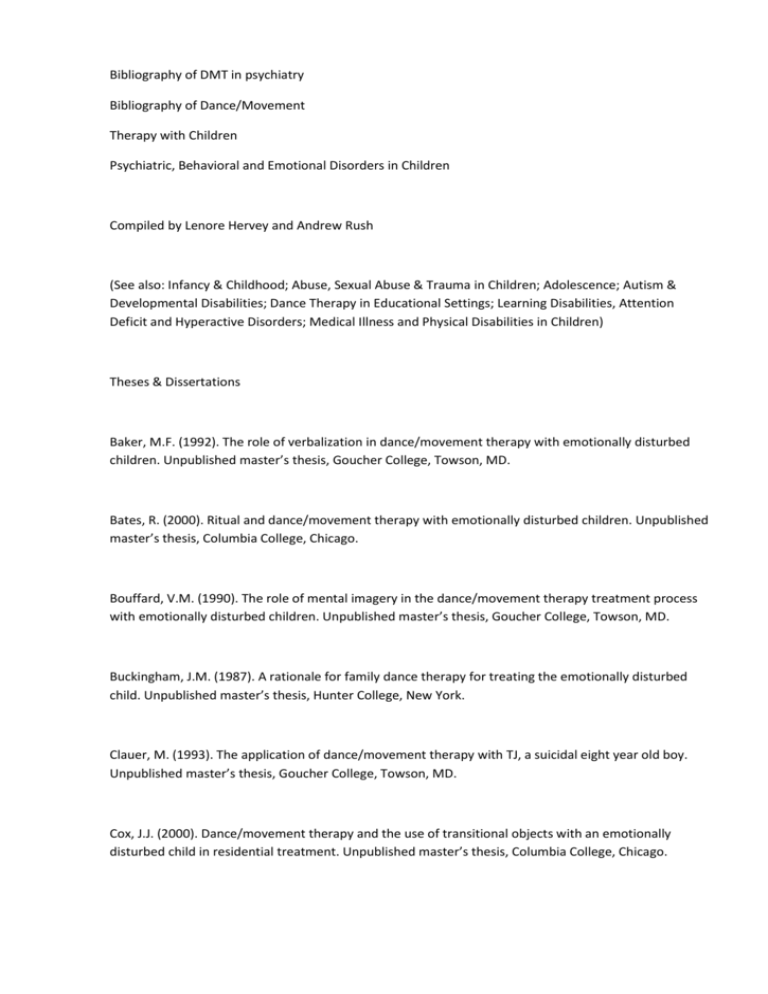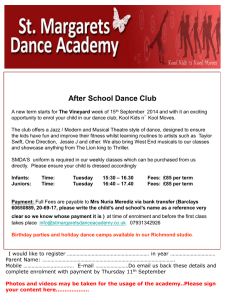Bibliography of DMT in psychiatry Bibliography of Dance/Movement
advertisement

Bibliography of DMT in psychiatry Bibliography of Dance/Movement Therapy with Children Psychiatric, Behavioral and Emotional Disorders in Children Compiled by Lenore Hervey and Andrew Rush (See also: Infancy & Childhood; Abuse, Sexual Abuse & Trauma in Children; Adolescence; Autism & Developmental Disabilities; Dance Therapy in Educational Settings; Learning Disabilities, Attention Deficit and Hyperactive Disorders; Medical Illness and Physical Disabilities in Children) Theses & Dissertations Baker, M.F. (1992). The role of verbalization in dance/movement therapy with emotionally disturbed children. Unpublished master’s thesis, Goucher College, Towson, MD. Bates, R. (2000). Ritual and dance/movement therapy with emotionally disturbed children. Unpublished master’s thesis, Columbia College, Chicago. Bouffard, V.M. (1990). The role of mental imagery in the dance/movement therapy treatment process with emotionally disturbed children. Unpublished master’s thesis, Goucher College, Towson, MD. Buckingham, J.M. (1987). A rationale for family dance therapy for treating the emotionally disturbed child. Unpublished master’s thesis, Hunter College, New York. Clauer, M. (1993). The application of dance/movement therapy with TJ, a suicidal eight year old boy. Unpublished master’s thesis, Goucher College, Towson, MD. Cox, J.J. (2000). Dance/movement therapy and the use of transitional objects with an emotionally disturbed child in residential treatment. Unpublished master’s thesis, Columbia College, Chicago. Fischer, J. (1987). Countertransference in dance/movement therapy with two severely emotionally disturbed girls: A case study. Unpublished master’s thesis, Hunter College, New York. Friedman, E. (1986). Integration of the “good/bad” split: A dance/movement therapy and dramatic play approach with an emotionally disturbed child. Unpublished master’s thesis, Antioch West Graduate School, San Francisco. Fuhrmann, H. (1988). A case study about a child with a symbiotic-psychotic syndrome using dance therapy in a short-term setting to build, to intensify and to terminate a therapeutic relationship. Unpublished master’s thesis, Langen Institut, Monheim, Germany. Glass, H. (1986). Humor as a transformational process in dance/movement therapy with emotionally disturbed preschool children. Unpublished master’s thesis, Antioch West Graduate School, San Francisco. Govrin, D.H. (1989). Moving towards separation and individuation: Developmentally based dance/movement therapy with an emotionally disturbed child. Unpublished master’s thesis, California State University, Hayward. Gronlund, E.C. (1994). Children’s emotions processed in dance: Dance therapy for children with early emotional disturbances. Unpublished master’s thesis, University of Stockholm, Sweden. Hoer, C. (1988). Description of dance therapy interventions focusing on the therapeutic relationship: Describing the individual therapy of an eight-year-old boy with a psychosomatic diagnosis. Unpublished master’s thesis, Langen Institut, Monheim, Germany. Levinbook-Mezamer, M. (1991). Developmental theory, object relations, and dance/movement therapy as combined references for therapy with emotionally disturbed children. Unpublished master’s thesis, Lesley College Graduate School, Cambridge, MA. Millrod, E.T. (1991). Object relations and play: Building houses in dance/movement therapy with emotionally disturbed children. Unpublished master’s thesis, New York University. Nielsen, T.L. (1989). The use of fantasy play in the movement therapy of a latency-aged child with aggressive conduct disorder. Unpublished master’s thesis, Antioch/New England Graduate School, Keene, NH. Omeragic-Mestanagic, G. (1992). Transferences and countertransference in dance movement therapy: A case study of an eight year old child with emotional and behavioral problems. Unpublished master’s thesis, Laban Centre for Movement and Dance, London. Payza, J.E. (1989). Group rollerdance: A pilot study on the use of play and dance therapy in the teaching of rollerskating to the emotionally disturbed, learning disabled, latency girls. Unpublished master’s thesis, Hunter College, New York. Robbins, B.D. (1988). The effectiveness of movement strategies in reducing physically aggressive behaviors in five to twelve year-old children hospitalized for severe conduct disorder. Unpublished master’s thesis, New York University. Ruf, C. (1989). Individual rituals of children as indicative of their psychological development and the effectiveness of dance therapy with a nine-year-old boy showing behavior dysfunctions. Unpublished master’s thesis, Langen Institut, Monheim, Germany. Ruzic, A. (2002). The influence of individual dance/movement therapy on the development of preschoolers in a partial psychiatric treatment program. Unpublished master’s thesis, Drexel University, Philadelphia. Schrage, M. (1988). The implementation of role play in therapeutic work with behaviorally imbalanced children. Unpublished master’s thesis, Langen Institut, Monheim, Germany. Scott, M.L. (1989). Dance movement therapy and the re-creation of the transitional object with seven severely emotionally deprived Black boys. Unpublished master’s thesis, Antioch/New England Graduate School, Keene, NH. Shaaltiel, M. (1988). A case study of an emotionally disturbed child. Unpublished master’s thesis, Hunter College, New York. Shmerling, J.D. (1988). The use of Laban Movement Analysis in dance therapy with an emotionally disturbed child. Unpublished master’s thesis, Laban Centre for Movement and Dance, London. Thomson, S. (1987). The use of specific props and activities to reduce the disruptive behavior of the emotionally disturbed child within the dance/movement therapy session. Unpublished master’s thesis, Antioch/New England Graduate School, Keene, NH. Visconti, D.M. (1991). A case of an emotionally disturbed girl. Unpublished master’s thesis, Hunter College, New York. Weikers, V. (1989). The movement parameters of and the efficacy of movement therapy with environmentally traumatized emotionally disturbed preschool children: A case study. Unpublished master’s thesis, Drexel University, Philadelphia. Journal Articles & Papers Erfer, T. & Ziv, A. (2006). Moving toward cohesion: Group dance/movement therapy with children in psychiatry. The Arts in Psychotherapy, 33, 238-246. Mentzer, M.C. & Boswell, B.B. (1995). Effects of a movement poetry program on creativity of children with behavioral disorder. Impulse: The International Journal Of Dance Science, Medicine, And Education, 3(3), 183-199. Parteli, L. (1995). Aesthetic listening: Contributions of dance/movement therapy to the psychic understanding of motor stereotypes and distortions in autism and psychosis in childhood and adolescence. The Arts in Psychotherapy, 22(3), 241-247. Rakusin, A. (1990). A dance/movement therapy model incorporating movement education concepts for emotionally disturbed children. The Arts in Psychotherapy, 17(2), 55-67. Schmerling, J. & Kerins, M.R. (1987). Stimulating communication in an elective mute: Collaborative interventions. American Journal of Dance Therapy, 10(1), 27-40. Shennum, W.A. (1987). Expressive activity therapy in residential treatment: Effects on children’s behaviors in the treatment milieu. Child and Youth Care Quarterly, 16(2), 81-90. Books and chapters from books Stanton-Jones, K. (1992). DMT in child and family psychiatry. In An introduction to dance movement therapy in psychiatry. (pp. 170-204). New York: Routledge.








